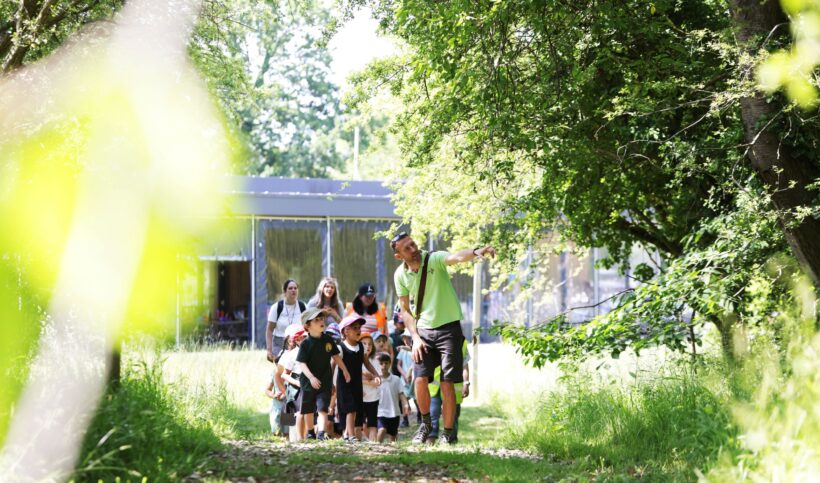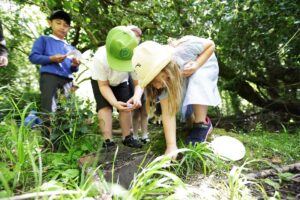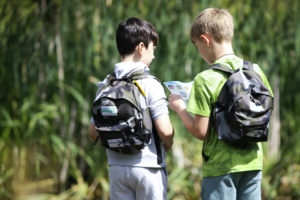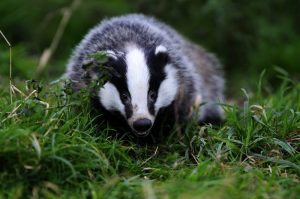Expectation versus reality in the woodland
Tuesday 13th August 2024

Click play if you would prefer to listen to this blog
Every adventure has some risks. And even though the outdoor activities at the Science Oxford Centre are a wonderful way to explore nature, part of my job is to assess and describe their risks so that all our visitors can be prepared.
So every summer, in moments of pause after the school term ends and between the busy schedule of holiday activities, I update essential risk assessments as part of our planning for next year’s programme.
What outdoor risks do children imagine?
Our risk assessments are shared with all Science Oxford Centre adults involved in the activities. But, before every activity we run, we also like to discuss with the children what they imagine the risks to be. In my outdoor role this can be particularly interesting, with all manner of potential hazards being identified. If the children are to be believed, we’d need mitigation measures in place for poison ivy, swarms of stinging insects, and of course bear, crocodile, shark and wolf attacks around every turn!
This discussion allows me to address any concerns they might have before we go on our adventure into the great outdoors. Letting them know that poison ivy, bears, wolves, and crocodiles are not found on our small island helps, but we can also talk about the best ways to prevent any stings (insect or nettle), avoid slips, trips and falls and ensure no one gets lost.
I do have to be careful not to make light of the ‘out there’ hazard suggestions. For example, while it is true that there are not any dangerously venomous spiders in the UK, a bite from a false widow might still be unpleasant. Perhaps more importantly, some of our visitors may hail from, or travel to countries where there really are dangerous spiders. To tell them that spiders are harmless would not be true.

“The most dangerous things we will see will be the plants”
It’s often a surprise when I say that “the most dangerous things we will see will be the plants”. What I am referring to are the likes of stinging nettles, thorns, and brambles, but also the potentially poisonous leaves, berries or fungi that are found on native species throughout our countryside. By looking carefully before we touch and avoiding eating anything while we are out, we can avoid risks relatively easily. We also ask all children to wash their hands carefully upon their return before breaking out their packed lunch.
Why would a plant be poisonous?
You may have wondered why do plants make themselves so nasty – why do some produce toxic compounds that make them poisonous, while others invest energy reserves making spiky leaves or stems? These adaptations most likely evolved to avoid being eaten, although this would be against grazing herbivores rather than small children.
These dangerous plants or fungi can also have huge benefits. Take one of the most poisonous plants out there – the European yew. Its seeds, bark and leaves contain poisonous alkaloids and these same chemicals have been used as active ingredients in medicines. The chemotherapy drug Taxotere, whose name derives from the Latin name for yew (Taxus baccata), uses these extracted alkaloids that prevent cell division in animals to treat early- and advanced-stage breast cancer before or after surgery.
Some hazardous plants, such as giant hogweed (Heracleum mantegazzianum), are genuinely dangerous without even needing to be consumed. Giant hogweed has a photosensitive sap which causes those coming into contact with it to come out in horrible blisters which can scar. It’s quite distinctive, standing at up to 4m tall, but otherwise resembles common hogweed (Heracleum sphondylium) or hemlock (Conium maculatum) which are rarely dangerous to touch but still highly poisonous if eaten. Report sightings of giant hogweed to your local council to prevent anyone coming to harm.
Stings and bites
In the UK, the dangerous animals we may come across are limited only to those that might bite or sting us, rather than eat us! The stingers will only do so in self-defense. Aside from the rarely seen adder, the biters are predominantly invertebrates that, while being rather annoying, are generally doing it for good reasons (to them). If not also defending themselves, they are probably feeding on your blood to stay alive. In some species, such as mosquitos, the females need this blood meal to produce their own offspring.
Here in England we may experience a bit of irritation at the bite site for a few days, but it’s worth remembering that, on a global scale, mosquitos hold the record for being the world’s most deadly animal due to the diseases they spread. Rather depressingly the second most deadly is us humans!
The weather
One thing we can’t control, even with judicious planning, is the weather. We rarely cancel our walks in the woods but we do have to if electrical storms are forecast, or in the event of high winds that could bring trees down. Appropriate clothing is usually all that is needed for most of what the Great British summer can throw at us, although these days whether that is hot and sunny or cold and wet is anyone’s guess. This summer, let’s hope we’re only in need of a bit of sunscreen and a bottle of water to stay safe outside.
Explore the outdoors
Grab an explorer’s backpack on your next visit to the Science Oxford Centre and see what plants, animals and fungi you can safely spot. Even with a few easily managed risks, a visit to the outdoors is always a wonderful experience!

To find out more about Science Oxford’s holiday activities, visit our What’s On page



